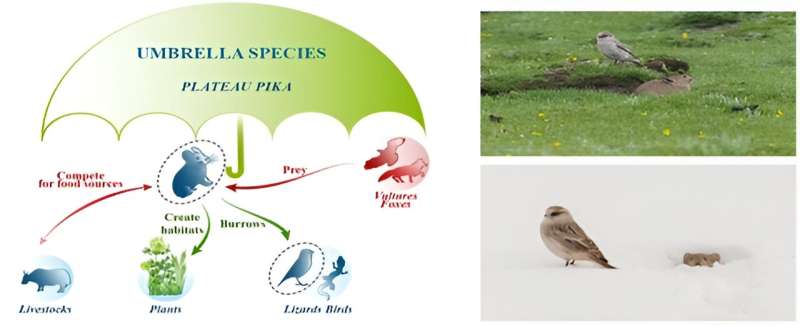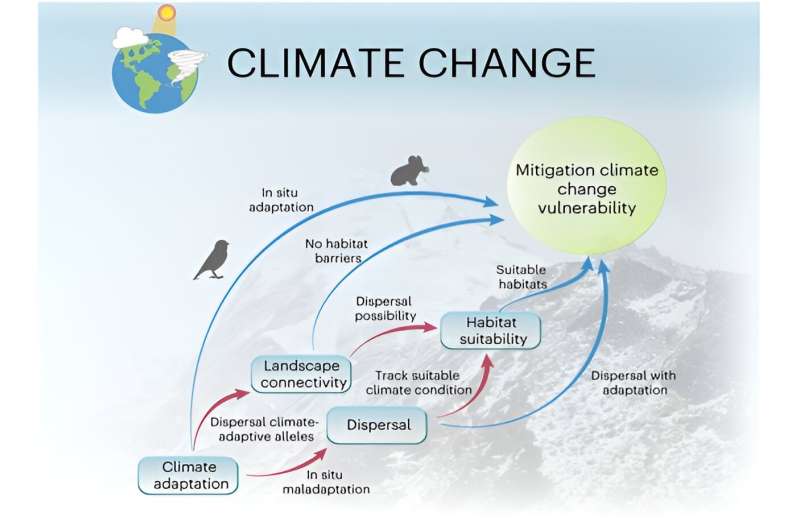This article has been reviewed according to Science X's editorial process and policies. Editors have highlighted the following attributes while ensuring the content's credibility:
fact-checked
peer-reviewed publication
trusted source
proofread
Plateau pika is umbrella species for conservation of alpine grassland ecosystem under climate change

How species cope with ongoing climate change is critical to preventing an exacerbation of biodiversity loss. The Qinghai-Tibetan Plateau (QTP) is the highest plateau in the world, and this extreme high altitude environment has driven the evolution of an exceptional biodiversity and endemism. The plateau pika (Ochotona curzoniae), a keystone species of the alpine grassland of the QTP, is critical to the dynamic equilibrium and sustainability of this ecosystem because of its burrowing behavior and it is the primary prey of several predators.
A fascinating example is that the burrows of the plateau pika provide nesting sites for two species of snowfinches (Onychostruthus taczanowskii and Pyrgilauda ruficollis). This particular behavior of burrow-sharing has fascinated people since the early 3rd century BC, as is documented in The Classic Mountains and Seas, an ancient Chinese account of the natural fauna and flora.
In a recent study published in Nature Climate Change, Chen Yilin and his colleagues from the Institute of Zoology of the Chinese Academy of Sciences have combined ecological genomics, ecological niche modeling, and landscape genetic approaches to assess population-level responses to future climate change in the plateau pika and two species of snowfinch.
They examined how the interplay between local climate adaptation, migration, habitat suitability, and landscape connectivity affects the vulnerability of species to climate change. For example, if climate change is rapid, local populations will need to adapt quickly to changing conditions to avoid extinction. Ecological niche modeling, i.e., habitat suitability, can predict which areas will have suitable future climate conditions.

To investigate whether the rapid adaptation of climate-sensitive species in the high-elevation QTP can keep pace with the climate change, the researchers measured genetic variation at climate-associated loci for the three species and modeled the risks posed by climate change at the population level. By simultaneously estimating multiple metrics of genetic maladaptation and considering both the migration capacity and landscape barriers, they showed that most populations in the southwestern parts of the range will not tolerate the predicted future climate conditions.
Conversely, populations living in the northeastern parts of the ranges are projected to be only slightly disrupted by climate warming, and thus may serve as climate conservation hotspots, i.e., climatic refugia for the many alpine endemics that represent an important part of the global biodiversity.
By comparing the climate change maladaptation and ecological niche shifts to future climate change, they found that the keystone species and the co-evolving species show similar population-level patterns of vulnerability to climate change. Keystone species are often regarded as potential umbrella species, but it has been questioned whether this conservation concept can be applied in regions affected by climate change.
The results of this study show that key species (umbrella species) can be used as indicators to reflect the risks of climate change faced by other species that co-evolve with them, and thus aid conservation management for the whole community.
In particular, by combining multiple assessments of climate change risk across a group of co-evolving species, this study provides a novel way to comprehensively assess population-level vulnerability to climate change, beyond the use of a single species and/or modeling predictions alone.
More information: Yilin Chen et al, Alpine burrow-sharing mammals and birds show similar population-level climate change risks, Nature Climate Change (2023). DOI: 10.1038/s41558-023-01772-8
Journal information: Nature Climate Change
Provided by Chinese Academy of Sciences



















